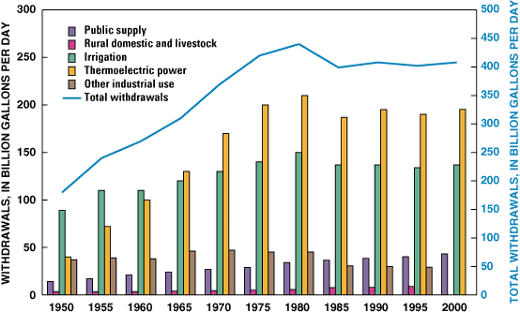
Trends in total water withdrawals by water use category. Source: U.S. Geological Survey
The power sector might be a major guzzler at the water well, but it is not the only one—agriculture, industry and public utilities are also competing for this ever more valuable resource.
In the fifties and early sixties, agriculture was the thirstiest of the four. But since 1965 thermoelectric power has taken the lead. In 2000, according to the U.S. Geological Survey publication, Estimated Use of Water in the United States in 2000 (the most recent government report—the next report is due late 2014), thermoelectric power accounts for about half of total water use nationwide.
Most of this water comes from surface water and is used for cooling the power plants. Approximately, 52 percent of fresh surface-water withdrawals and about 96 percent of saline-water withdrawals are for thermoelectric-power use.
Even now the next biggest contender is agriculture, which uses water primarily for irrigation. Irrigated acreage more than doubled between 1950 and 1980, then remained constant before increasing nearly 7 percent between 1995 and 2000.
The public-supply sector has likewise begun to use up more and more water. Public and private water suppliers fall into this category, providing water for domestic, commercial, or general public use. In 1950, only 62 percent of the U.S. used public drinking water; that changed to 85 percent by 2000. Public-supply not accounts for about 11 percent of water use in 2000.
The industrial sector, contrary to the other three, has reduced its percentage of the water pie in the last twenty years. This sector includes water used for processing, washing, cooling, and producing chemical products, food and paper products. Industrial water use in 2000 was nearly 25 percent less than that of 1985 and is currently at its lowest level since reporting began.
In general, water withdrawal increased steadily from 1950 to 1980 with large industrial, irrigation, and thermoelectric power withdrawals creating the 1980s peak. Since the 1990s, however, water withdrawals haven’t changed much: total withdrawals for 2000 proved no higher than those in 1990, even though the U.S. population increased by 13 percent that decade.








